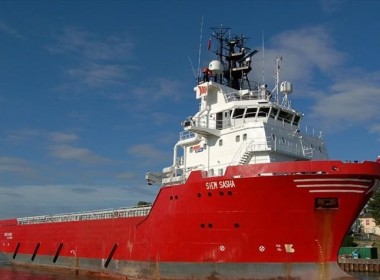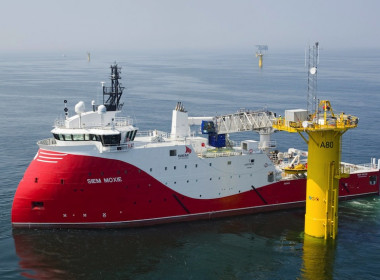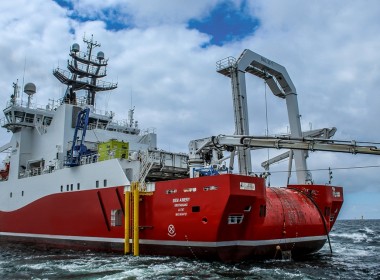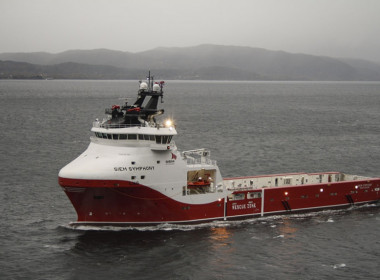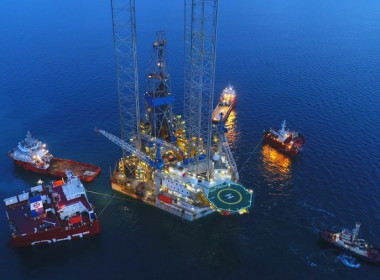COLUMN | Correcting course: Aramco and jackups; Siem Offshore and Kristian Siem; Ferguson Marine; MMA Offshore; Maersk/Svitzer [Offshore Accounts]

Harold Macmillan was supposedly once asked what the most troubling problem of his time as British Prime Minister was. “Events, my dear boy, events,” was his reply.
I thought I had this week’s column nailed well in advance, but offshore is an industry especially susceptible to unexpected and hard to predict “events”.
So, we must deal with big developments in Saudi Arabia and Norway before we update you on the Ferry Fiasco in Scotland, and make a humble apology to a public relations team in Australia. Then we berate the board of Maersk for utter folly.
Let’s not talk about Cadeler’s awful results
There’s so many events that we don’t even have time to mock the ridiculous results announcement from Cadeler that you can read many times over, without realising that the company’s 2023 full-year net profit fell 67 per cent to just €11.5 million (US$12.5 million).
The words “profit” and “income” appear nowhere in the Cadeler results announcement, and you have to dig into the annual report itself to see the extent of the collapse in net income. Despite this shocking fall in profit, one mustn’t worry; in order to retain talent, the executive management doubled their own compensation to US$2.87 million – taking 20 per cent of the entire net profit of the company (a detail buried on page 127 of the report).
Just think how much they will pay themselves if they actually manage to increase profits in 2024 rather than slashing them!
Take a leaf out of Quintin Kneen of Tidewater’s book – management should only profit when the company prospers, not when profits are falling and the stock is stagnant.
Saudi Aramco delivers shock!
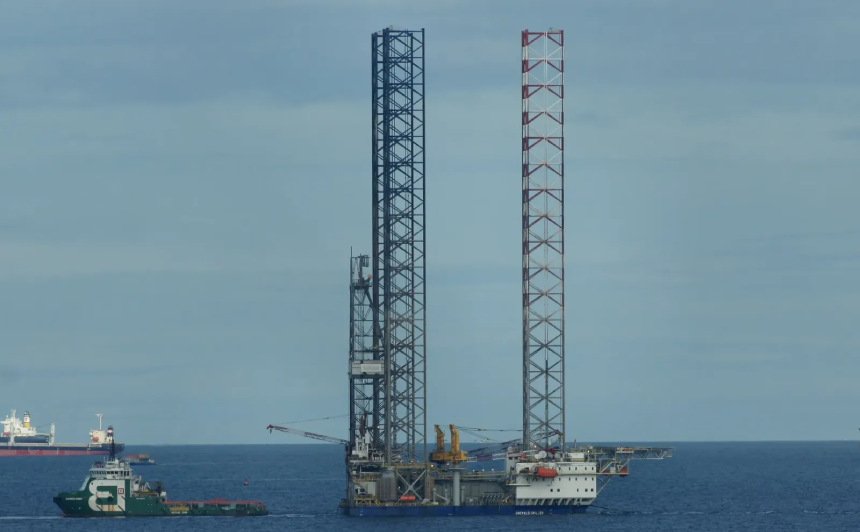
On March 24, Saudi Arabian state-owned jackup drilling rig owner ADES announced it had been awarded a letter of intent by PTTEP in Thailand for its 2013-built rig Admarine 502 to work for 18 months firm plus nine months of options after completing its contract in Saudi Arabia. The PTTEP day rate was much lower than previous fixtures for international jackups, with ADES estimated to earn around US$115,000 per day after mobilisation costs, whereas the previous benchmark rate for premium jackups was around US$150,000 per day.
When the news broke, the lower rate was initially explained away by the fact that ADES is very focused on its main client Saudi Aramco, and currently has no rigs drilling outside of the Egyptian Red Sea, India, and the Arabian Gulf.
At the end of last year, ADES was awarded a charter with Pertamina Drilling Services Indonesia for its jackup drilling rig Emerald Driller in the Java Sea, but this work only starts in the second half of the year. Therefore, it did not seem to be a cause for concern, even though it might be a little odd for a rig owned by a Saudi state company to leave the Arabian Gulf for Thailand.
The background: capacity plan reduced
In January, the government in Riyadh had reduced Saudi Arabia’s national oil production capacity target from 13 million barrels of oil per day (bpd) down to 12 million bpd, as we reported. This led to the postponement of several high-value, high-volume oil projects offshore by state-owned oil company Saudi Aramco, including the US$7 billion Manifa project and a reported US$10 billion planned investment in the Safaniyah field.
In mid-March, Saudi Aramco said that it expected to reduce its capital investment by approximately US$40 billion between 2024 and 2028 as a result of the lower production capacity requirement from the government.
Jackup rigs flood into the Kingdom
As of the end of March 2024, Saudi Aramco had 89 jackups under contract. Recent growth in the jackup market had been driven entirely by clients in the Arabian Gulf, especially Saudi Aramco and Abu Dhabi’s ADNOC. As recently as mid-2022, Saudi Aramco had only 50 jackups in operation. From 2020 to 2023, net 48 rigs moved into the Middle East from other regions, as ADNOC and Saudi Aramco ramped up drilling – Westwood Energy has an excellent analysis here showing how the Gulf rig count rose to 189 units, half of global demand.
Saudi Arabia’s state-owned rig owner ADES bought 26 jackups over the period to boost its offshore fleet to 49 units, as we described, and promptly listed on the Riyadh stock exchange at the end of last year.
Saudi Aramco’s drive to contract jackups has led to global utilisation hitting over 90 per cent and leading day rates to almost double between 2020 and 2024.
“Saudi Aramco and ADNOC are more than 25 per cent of jackup demand, so if those two companies reduce drilling, there is a risk,” we observed on Twitter in January. “The same risk applied in deepwater in Brazil in 2008 to14 – that ended badly.”
Shelf Drilling gets a nasty letter
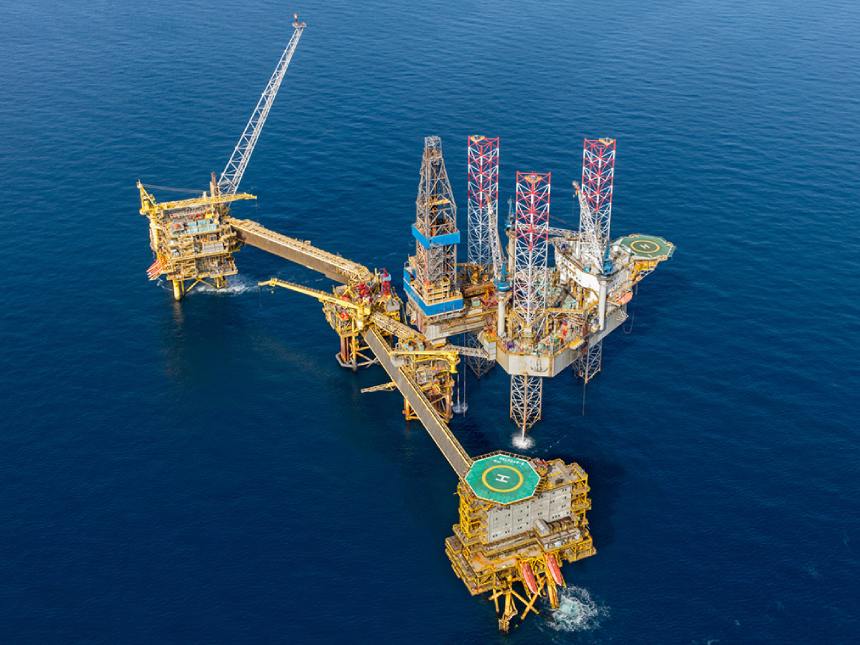
On April 1, signs that the jackup market might be taking a dip emerged when Shelf Drilling delivered sombre news regarding some of its nine rigs on contact to Saudi Aramco. Shelf reported it “has received a notice of suspension of operations of four jackup rigs from a customer in the Middle East. The company is in active discussions with the customer to determine which rigs will be suspended and the exact timing of the suspensions. Shelf Drilling understands that during the suspension period it will have the right to actively market the rigs to other customers and opportunities and to terminate the applicable contracts.”
Ouch. With the naivete of youth, we assumed that foreign rig contractors would bear the brunt of any reduction in Saudi Aramco’s rig requirements.
We were wrong.
Saudi Aramco suspends 18, probably 23 jackup rigs
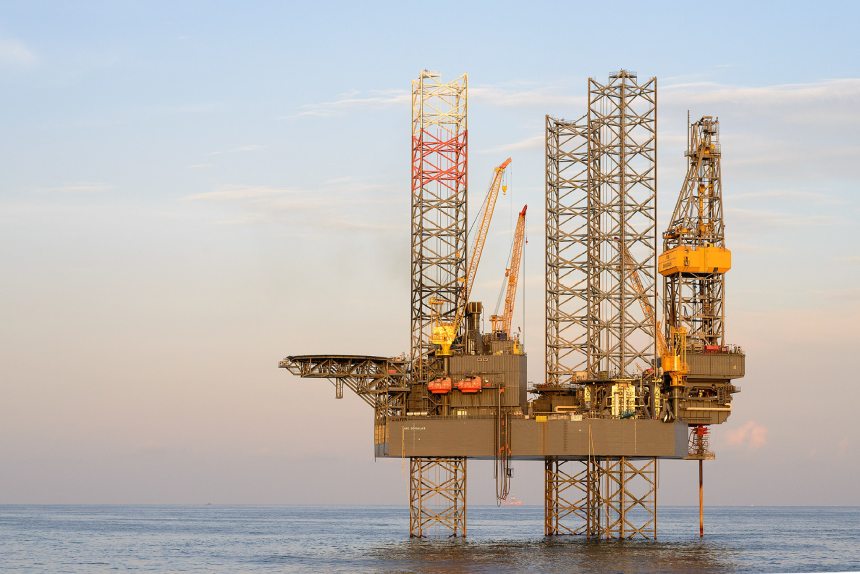
Unfortunately, it turned out that Saudi Aramco was busy writing other suspension notices for at least 18, and probably up to 23 jackups in total.
Even ADES was not spared. Suspension means the rigs will stop operations and not be paid by Aramco until they are instructed to restart operations.
New York-listed Valaris, Norway’s Borr Drilling, and China Oilfield Services (COSL), along with local players ADES and Arabian Drilling, all received notices of suspension from Saudi Aramco last week, as well as Shelf. So far, these listed companies have disclosed a total of 18 rigs being suspended by the state oil company for up to a year, with the suspended period to be added to the duration of the contracts.
Borr Drilling had one of its three jackups working for Saudi Aramco, Arabia I, suspended, COSL had to suspend the operation of four rigs, whilst Valaris informed investors that its ARO Drilling joint venture with Saudi Aramco itself “received a notice of suspension from Aramco for one of its 19 contracted rigs,” being the jack-up Valaris 143. Yes, Saudi Aramco even suspended a rig operated by its own joint venture.
ADES informed the Riyadh stock exchange about its “mutual agreement” with Saudi Aramco to temporarily suspend operations on five from its 33 offshore jackups operating in the Kingdom, including Admarine 502. Arabian Drilling announced that it is currently in discussions regarding contract suspension for three of its offshore rigs with Saudi Aramco.
Esgian has reported in its excellent weekly summary that in addition to these 18 jackups, sources have indicated that three Saipem jackups and two Egyptian Drilling units are also receiving suspension notices.
What are the consequences?
This mass suspension in Saudi Arabia is major news for the jackup drilling market. It is a reminder of the fickle and capricious nature of government in the Kingdom.
The fixture of the Admarine 502 at US$115,000 sets a new benchmark for a segment of the industry, which is likely to see weaker pricing for the next twelve months until the suspended rigs are re-employed by Saudi Aramco or have found work elsewhere with other clients.
In early 2020 when Covid struck, the termination of contracts due to the pandemic and a dramatic fall in the oil price led to six of the seven major international drilling companies going bankrupt and filing for Chapter Eleven. Four years on, the market is much stronger, day rates and utilisation are much higher, and companies are less indebted.
Jackup company stocks had already suffered when Aramco announced its capacity target reduction. Borr Drilling shares are down 20 per cent to US$5.79 year to date, and ADES stock has fallen 25 per cent since January 1, whereas pureplay deepwater driller Transocean is up five per cent.
Until jackup rates are seen to start to recover back up to the US$150,000 per day level, there is likely to be some uncertainty. Nobody anticipated this dip in activity in Saudi Arabian activity and nobody saw 23 rigs being impacted, a quarter of Aramco’s demand, not even when Shelf received the first letter last Monday.
Consequences for offshore vessel owners
There is also likely to be a knock-on effect in the offshore support vessel (OSV) market. Each suspended rig is probably supported by two platform supply vessels (PSVs) or anchor handling tug supply vessels (AHTS), so the 20 or so rig suspensions reduce demand by around 40 vessels, and some crewboats and fast supply vessels. This will inevitably impact regional rates in the 80-tonne, DP2 AHTS market and in the mid-size 600-square-metre clear deck PSV segment, where Aramco is a major customer.
As we saw when we reviewed Tidewater’s results last month, the Middle East is a market where the company has 45 vessels working at close to break-even. It is a dog of a market and we have twice called on Tidewater to sell off the operation or get out of the Gulf.
This weak profitability is unlikely to be improved by Aramco’s news, and we can expect, perhaps, news of vessel suspensions to trickle out when the dates of the rig suspensions are finalised. Esgian believes that the jackup suspensions will be staggered, so it is not as if all 23 rigs and 40 supply vessels will suddenly be off-hired in the same week and end up idle in Bahrain or the Emirates, all at once. Indeed, there may be a short-term spike in demand for towages to remove the suspended rigs from the kingdom.
But the suspensions will increase competition in regional vessel bids and will likely see some vessels transfer out of the Gulf to other areas, especially India, South-East Asia, and even West Africa. The medium size, again, Admarine 502 is leading the way. Norwegian finance house Pareto has speculated that one big winner may be Petronas Carigali in Malaysia, which has a two-year programme for a premium jackup starting in January next year. If that fixture is below US$100,000 you can see alarm bells ringing, but if Petronas pays above US$120,000, there will be relief all around.
Norway does it again – minorities abused
Norway is famous for its liberal tolerance and moderate Scandinavian politics, so when we speak of minorities being abused, don’t be alarmed. We refer instead to a vulnerable group who have been long exploited by the country’s super-rich: minority shareholders.
Last year, we observed with concern how Solstad Offshore’s largest shareholder, Norwegian tycoon Kjell Inge Røkke, managed to dismember the company and transfer 22 of Solstad’s construction support vessels and 14 AHTS into a new entity of which his Aker Group owns 73 per cent. The existing shareholders in Solstad Offshore got only 27 per cent of this new company, and were left with just three old Brazilian anchor handlers, a well stimulation vessel, a seismic support ship, and one subsea unit in the legacy public company.
And all this was apparently completely legal under Oslo stock exchange rules.
Siem Offshore no longer owned by Kristian Siem
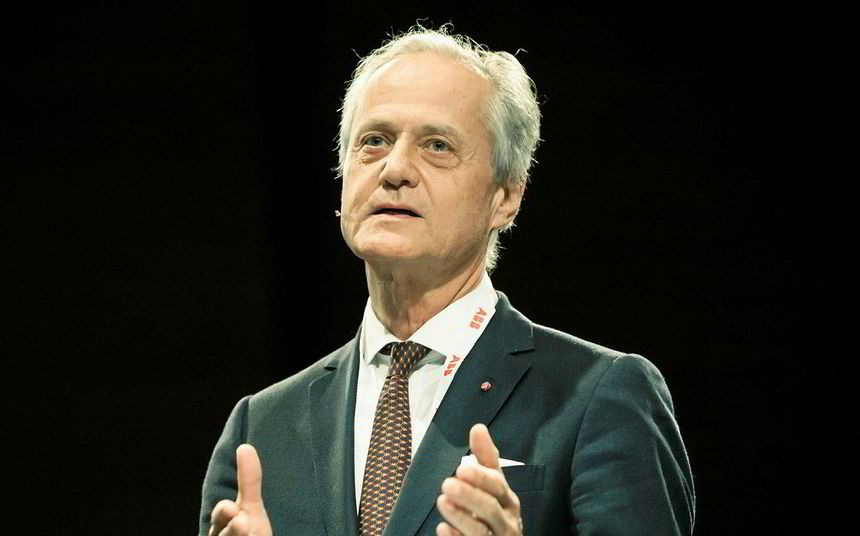
Now another tycoon is dismembering an offshore support vessel company, one named after himself.
On Friday, Siem Offshore announced that it has agreed to sell nine of its vessels (being Siem Barracuda, Siem Stingray, Siem Opal, Siem Pearl, Siem Topaz, Siem Pilot, Siem Pride, Siem Symphony and Siem Thiima) to its eponymous major shareholder, Kristian Siem and his Siem Sustainable Energy and related companies.
The price? The 35 per cent of Siem Offshore that Kristian Siem previously owned. Siem will thereafter cease to be a shareholder in the company, and Mr Siem will stand down from the board in May 2024.
The nine vessels are three AHTS, four PSVs and two subsea vessels (Siem Barracuda and Siem Stingray). The vessels will be transferred to Mr Siem “as soon as practical,” the company says, and anyway before July 1, 2024. Kristian Siem’s companies will assume US$117.5 million of existing vessel debt as part of the transaction. Siem Offshore made a net profit of US$100 million for 2023 (nearly nine times larger than Cadeler, we note).
Siem Offshore, which will presumably shortly change its name, says it will continue to manage the nine ships Mr Siem is buying, under ship management agreements for a minimum period of one year.
In one of the most bitter-sweet comments of the year so far, Kristian Siem, still the Chairman of Siem Offshore, commented on the transaction in a press release:
“The company has two major shareholders with different values, culture, and objectives. Clear focus in the direction of the company’s organisation is essential for results. There are several ways forward which may serve the company well, but only one avenue can be chosen and only one party can hold the helm. I have spent the past 30 years building the company with an effective organisation which enjoys a high reputation. My job is completed and I hand over to other owners. I thank all the people in the company, on shore and offshore, for their contribution to this journey, for their loyalty to the company’s long term interest and for the pleasure it has been working together. My hope is that the new leadership will stay on a steady course and I wish the company and all my past colleagues well.”
The other major shareholder is Kistefos, owned by Christen Sveaas, which previously controlled 33.3 per cent of Siem Offshore. Looking ahead, Sveaas will now neatly own 51 per cent of the remaining business, which should presumably be renamed Sveaas Offshore or Kistefos Offshore.
Mr Sveaas is left controlling five large and one small AHTS, two PSVs, two offshore subsea construction vessels, two well intervention vessels, one scientific core-drilling vessel, and four small fast crewboats and oil spill recovery vessels, of which two were in lay-up at the end of 2023 (plus three third party vessels under management, soon to be twelve).
Cue Roxette: It must have been love.
Ferguson Marine CEO in ferry fiasco firing
Scotland’s long-running shambles in the construction of taxpayer-funded Ro-Pax ferries Glen Sannox and Glen Rosa at the taxpayer-owned shipyard Ferguson Marine claimed another victim last month.
Ferguson CEO David Tydeman has been fired. He had told the government that further delays were likely to the delivery of the vessels, which are already six years late and more than US$300 million over-budget. He is being replaced by John Petticrew, who has been a non-executive director of Ferguson since 2022.
The hilariously titled Scottish “Wellbeing economy secretary” Mairi McAllan told The Herald newspaper that further delays and cost overruns were inevitable unacceptable, and said that she was “focused on the Scottish government’s priorities of completing the two ferries, ensuring [Ferguson Marine] drives down on costs, and securing a sustainable future for the yard and its skilled workforce.”
Sources told Baird that the yard would consider only building “simple ferries” in future, and that entry into the booming PSV and AHTS or wind service markets would not be considered at this time.
It is good to see that the British tradition of shooting the messenger lives on. The opposition transport secretary voiced sentiments with which we would agree:
“The only people not held accountable are those who are most responsible: the Scottish National Party Government. It beggars belief that not a single ministerial resignation has been offered when the buck stops with them for years of grotesque mismanagement of Scotland’s ferry network.”
“Dear Editor, Hieronymus is wrong”
We love it when people write in to correct us. Last week, it was the turn of the indefatigable public relations team from MMA Offshore, the subject of a US$673 million take-over by Singapore’s Cyan. The folks at FTI Consulting made the very valid point that MMA had written back the value of its fleet in 2022 and 2023 when the offshore market recovered, reversing the previous impairments it had made, whereas we had insinuated that the assets remained impaired. Our knuckles were duly rapped, sorry. They then added the following:
“So, the vessels are currently carried on the balance sheet at a normalised cost less depreciation. The most recent written down carrying value for the vessels is AU$437.3 million (as at 31 December 2023). You can also determine from the same set of accounts that the original cost of the vessels was AU$709.1 million when they were built, which may be an interesting marker for the overall deal value of AU$1.03 billion (All $ figures mentioned are AUD, which is MMA’s reporting currency).”
These people in Perth must be geniuses, I thought. They managed to sell the 18 vessels in the fleet for much more than they bought them ten years ago, which is quite an achievement. How was this even possible?
There was a new subsea business added to MMA when it bought Neptune Marine Services and its fleet of remotely operated vehicles in 2019, but this didn’t explain the massive premium.
Then I remembered the massive currency depreciation the Aussie dollar has experienced. OSVs are valued and bought and sold in US dollars, regardless of whether the company buying them reports in Aussie dollars, Nigerian Naira, or Indonesian Rupiah.
Aussie dollar going down
In June 2014, when ten of the 18 MMA-owned MMA offshore vessels joined the company’s books through the US$495 million acquisition of the fleet and equipment of Jaya Holdings in Singapore, one US dollar bought you AU$1.06. Today, one US dollar buys you 1.53 Pacific Pesos Australian dollars.
You can see where this is leading. The original AU$709.1 million acquisition cost of the current MMA fleet was actually US$669 million, based on the end-June 2014 exchange rates, which is likely to be close to the real US dollar price paid for the ships. The written down value of the fleet depreciated from that US dollar starting point today is US$413 million. So, Cyan is paying a premium, but the currency effect distorts the actual, underlying price of the ships and of the entire company.
MMA has achieved a good price for its shareholders from Cyan, but looking at the deal in US dollar terms removes a lot of the hyperbole.
Pacific Peso is joined by the Bergen Bolivar?
Unfortunately, a billion Aussie dollars buys you a lot less internationally today than it did in the glory days of the last resource boom, when it traded at parity or above the greenback from 2010 to 2013.
The same is true in Norway, where one US dollar bought you six krone in June 2014, whereas now it buys you nearly NOK11. This could explain why Norwegian banks with NOK-denominated balance sheets were so keen to receive US$577 million from Tidewater for Solstad’s 37 PSVs in 2023 – the US dollar offer probably made them much closer to being whole in local currency terms.
And pity Russia, where in 2014 one dollar bought 33 rubles, and now it is worth over 93 rubles. Ouch. Even the best PR people struggle with that narrative.
Just say “no”: Svitzer spin-off is a terrible idea
Unfortunately, we have little time and space to muse upon why the one company in the world most desperately in need of tugs (Maersk) would choose to spin off its in-house tug subsidiary (Svitzer) just as one of its chartered container vessels is involved in a multi-billion disaster (the Baltimore bridge collapse), which killed six.
The Board of Directors of Maersk intends to propose the demerger of Svitzer, which operates 456 vessels performing towage services in 141 ports and 40 offshore terminals, for approval by shareholders at an extraordinary general meeting expected to be held on April 26.
Just say “no”, we urge shareholders
Large containerships need more and better towage, not penny-pinching exercises in outsourcing. If safety is core to the Maersk Group, Maersk should keep Svitzer in-house.
For Maersk to consider a spin-off of Svitzer is a sign of how what was once the world’s largest container company has completely lost its way. Integrated logistics won’t prevent another marine disaster like Dali hitting Baltimore’s Francis Scott Key Bridge; more and better harbour towage will.
Safe marine operations are central to a container shipping line, and towage is central to safe harbour berthing and transit.
Enough said.
Further reading
Our most recent coverage of Ferguson and the Ferry Fiasco was in December and September 2023. For the rest of the sad saga, Wikipedia has a succinct summary.
More on Svitzer and its two centuries of towage is available on the company home page.
Interested readers may want to watch a livestream of the launch of the ferry Glen Rosa via Ferguson Marine’s official LinkedIn page. The launch is scheduled for 13:00 Glasgow time. More details are available here.


